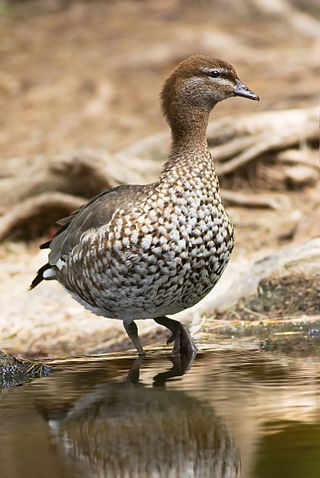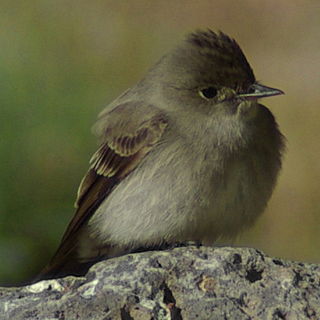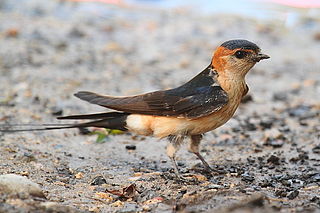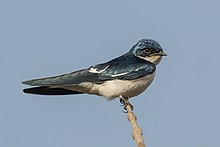
The longclaws are a genus, Macronyx, of small African passerine birds in the family Motacillidae.

The eastern wood pewee is a small tyrant flycatcher from North America. This bird and the western wood pewee were formerly considered a single species. The two species are virtually identical in appearance, and can be distinguished most easily by their calls.

The Australian wood duck, maned duck or maned goose is a dabbling duck found throughout much of Australia. It is the only living species in the genus Chenonetta. Traditionally placed in the subfamily Anatinae, it might belong to the subfamily Tadorninae (shelducks); the ringed teal may be its closest living relative.

The pewees are a genus, Contopus, of small to medium-sized insect-eating birds in the Tyrant flycatcher family Tyrannidae.

The white-winged swallow is a resident breeding swallow in tropical South America from Colombia, Venezuela, Trinidad, and Argentina. It is not found west of the Andes. This swallow is largely non-migratory.

Myiozetetes is a small genus of passerine birds in the tyrant flycatcher family. The four species occur in tropical Central and South America.

The dusky crag martin is a small passerine bird in the swallow family. It is about 13 cm (5 in) long with a broad body and wings, and a short square tail that has small white patches near the tips of most of its feathers. This martin has sooty-brown upperparts and slightly paler underparts. The two subspecies are resident breeding birds in South Asia from the Indian subcontinent to southwestern China and the northern parts of Thailand, Vietnam and Laos.

The afep pigeon, also known as the African wood-pigeon or gray wood-pigeon, is a member of the family Columbidae which lives in the Equatorial Forests of Africa.

The fawn-breasted tanager is a species of tanager with a blue head and yellow breast. It occurs in the Andes of northwestern Argentina, Bolivia, Colombia, Ecuador, Peru and Venezuela, as well as in the highlands of northeastern Argentina, south Brazil, Paraguay and Uruguay.

The Adamawa turtle dove is a species of bird in the pigeon and dove family Columbidae. It is also known as the pink-bellied turtle dove. The species is closely related to and has been considered the same species as the dusky turtle dove. The species has a disjunct distribution, being native to Cameroon, Nigeria and southwestern Chad and further west in Gambia, Senegal and Mali. It has also been reported defending a territory in Togo, suggesting a population may exist there too.

The short-legged ground roller is a species of bird in the ground roller family Brachypteraciidae. It is the only living species in the genus Brachypteracias and is endemic to Madagascar. It is threatened by habitat loss.

The white-headed wood hoopoe is a species of bird in the family Phoeniculidae.

Lewinia is a genus of birds in the family Rallidae.

The white-banded swallow is a species of bird in the family Hirundinidae. It is black with white thighs, a white breast, and has white bars on the edges of its wings. It has a distinct, deeply forked tail.

The banded yellow robin or olive-yellow robin is a species of bird in the Australasian robin family Petroicidae that is found in New Guinea. It is the only species in the genus Gennaeodryas. Its natural habitats are subtropical or tropical moist lowland forest and subtropical or tropical moist montane forest. It is threatened by habitat loss. It has a high mortality rate due to its inability to traverse across a matrix.

The marsh antwren, also known as the Paraná antwren, is an insectivorous bird in the antbird family Thamnophilidae. It is endemic to marshes and swamps in the Brazilian states of Paraná and Santa Catarina.

The Chilean swallow is a species of bird in the family Hirundinidae. It breeds in Chile and Patagonia, migrating north as far as Bolivia, Paraguay, and Rio Grande do Sul.

Tolmomyias is a genus of Neotropical birds in the tyrant flycatcher family Tyrannidae. It is one of the two genera containing the "flatbills"; the other is Rhynchocyclus.

Tregellasia is a genus of birds in the family Petroicidae that are found in Australia and New Guinea.

Cecropis is a genus of large swallows found in Africa and tropical Asia. The red-rumped swallow's range also extends into southern Europe, and into Australia. This genus is frequently subsumed into the larger genus Hirundo.























